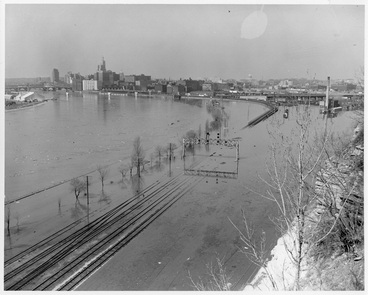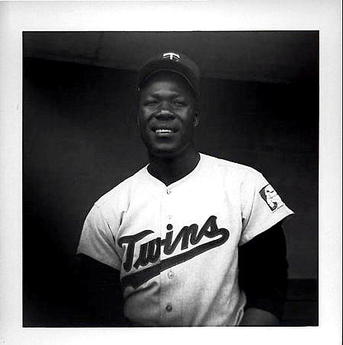 Courtesy Philip C. Dittes, Minnesota Historical Society
Courtesy Philip C. Dittes, Minnesota Historical Society A year ago, many residents living across the northern half of the continent endured a lengthy close encounter with the polar vortex, during one of the coldest and snowiest winters in years. More of the same has been predicted for the months ahead, though so far this winter has been milder for most of us in the Midwest.
Our current state of winter doesn’t compare, however, to the extreme weather that beset the upper Midwest 50 years ago. Temperatures were below normal in late 1964 before plunging below -40 degrees across much of Minnesota on January 14, 1965. Readings dipped to -50 in the northeastern Minnesota towns of Cook and Cotton.
Snow was light early in the season, allowing the frost to penetrate deep into the ground. Then the snow came, with a record 66 inches recorded in March alone in Collegeville, Minnesota. Snow heavily blanketed the state, and it stuck around when March temperatures were among the coldest ever recorded in Minnesota and Wisconsin.
Spring followed with a vengeance. After heavy snowfall continued well into March, the late thaw prolonged the inevitable flooding. The Vermillion River near Hastings was the first to overrun its banks. Soon after, communities along the Minnesota, Blue Earth, Crow, St. Croix and Mississippi rivers struggled to stay above climbing water levels. Some towns were deluged by floodwaters from more than one source.
On a daily basis, newspapers and TV newscasts featured images of anxious residents piling sandbags and building dikes. At least 22,000 Minnesotans were forced from their homes during the worst flood season in the region’s recorded history.
The mighty Mississippi wreaked havoc for weeks, but in time, the Twins and the 1965 American League pennant race captured the attention of baseball fans across the upper Midwest. In just their fifth year following the franchise move from Washington, the Twins dethroned the five-time AL champion Yankees.
Our current state of winter doesn’t compare, however, to the extreme weather that beset the upper Midwest 50 years ago. Temperatures were below normal in late 1964 before plunging below -40 degrees across much of Minnesota on January 14, 1965. Readings dipped to -50 in the northeastern Minnesota towns of Cook and Cotton.
Snow was light early in the season, allowing the frost to penetrate deep into the ground. Then the snow came, with a record 66 inches recorded in March alone in Collegeville, Minnesota. Snow heavily blanketed the state, and it stuck around when March temperatures were among the coldest ever recorded in Minnesota and Wisconsin.
Spring followed with a vengeance. After heavy snowfall continued well into March, the late thaw prolonged the inevitable flooding. The Vermillion River near Hastings was the first to overrun its banks. Soon after, communities along the Minnesota, Blue Earth, Crow, St. Croix and Mississippi rivers struggled to stay above climbing water levels. Some towns were deluged by floodwaters from more than one source.
On a daily basis, newspapers and TV newscasts featured images of anxious residents piling sandbags and building dikes. At least 22,000 Minnesotans were forced from their homes during the worst flood season in the region’s recorded history.
The mighty Mississippi wreaked havoc for weeks, but in time, the Twins and the 1965 American League pennant race captured the attention of baseball fans across the upper Midwest. In just their fifth year following the franchise move from Washington, the Twins dethroned the five-time AL champion Yankees.
 Jim "Mudcat" Grant
Jim "Mudcat" Grant 2015 marks the 50th anniversary of Minnesota’s first trip to the World Series. Over the course of the new year, this space will feature coverage of that magical Twins season. Manager Sam Mele led an injury-stricken club, which lost slugger Harmon Killebrew and pitching ace Camilo Pascual for lengthy stretches, to 102 wins.
Cuban stars Zoilo Versalles and Tony Oliva were top MVP candidates after their impressive second-half performances, and Don Mincher, Bob Allison and Jimmie Hall added pop to one of the game’s most productive lineups. Jim “Mudcat” Grant won 21 games in a career year, with both Jim Kaat (18 wins) and Jim Perry (12 wins) pitching their share of big games down the stretch. Although the 1965 Twins were a young club, they succeeded with veteran 30-something relievers Al Worthington and Johnny Klippstein recording the final outs.
Cuban stars Zoilo Versalles and Tony Oliva were top MVP candidates after their impressive second-half performances, and Don Mincher, Bob Allison and Jimmie Hall added pop to one of the game’s most productive lineups. Jim “Mudcat” Grant won 21 games in a career year, with both Jim Kaat (18 wins) and Jim Perry (12 wins) pitching their share of big games down the stretch. Although the 1965 Twins were a young club, they succeeded with veteran 30-something relievers Al Worthington and Johnny Klippstein recording the final outs.
 RSS Feed
RSS Feed
